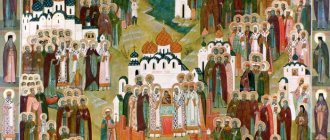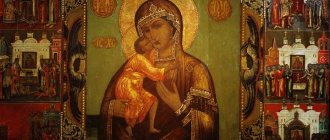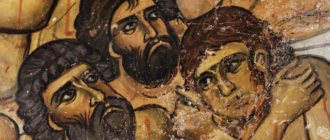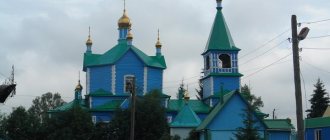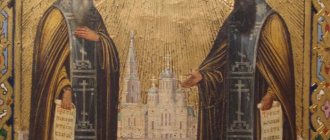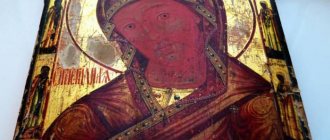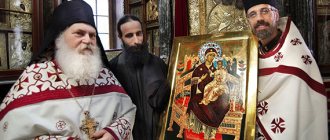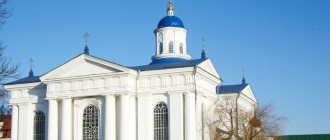The icon “Church Militant” received its name not from church ministers, but from Soviet art critics. In fact, the icon is called “Blessed is the army of the Heavenly King”, after the first line of the liturgical hymn about the martyrs, which states that all the martyrs who suffered for the Savior and accepted death in His name become members of the army of the Heavenly King.
After his successful campaign against Kazan in 1552, Tsar Ivan the Terrible ordered an icon to be painted on this subject. It is not known exactly when the royal order was completed. Archpriest Andrei, the royal confessor (later Athanasius, Metropolitan of Moscow), is usually named as its creator. Since 1919, the icon “Church Militant” (16th century) has been in the Tretyakov Gallery.
The subject of the icon “The Church Militant”
This complex multi-figure composition is striking in its scale, and the point is not so much in the size of the icon (144 × 396 cm), but in its content, based on the Revelation of John the Theologian and the writings of the apostles and prophets.
In the center of the icon is a procession of warriors, mounted and on foot, led by the Archangel Michael the Archangel, seated on a winged horse. They move from the right side, where a city engulfed in flames is depicted, to the left, where the Queen of Heaven sits in Heavenly Jerusalem with the Baby Jesus in her arms. Angels fly towards the warriors, crowning the righteous. It is noteworthy that not all warriors have halos. It is believed that warriors with halos are those who died in battle, and those without halos are those who survived.
Some art historians express the opinion that fire does not destroy the city, but cleanses it of filth. This is exactly how the fire was perceived by Presbyter Andrei, the royal confessor who participated in the campaign and is credited with painting the icon.
On the left side of the “Church Militant” icon, the Queen of Heaven sits with the Baby Jesus in front of the city gates; he hands the angels crowns for crowning the righteous. But this city is not ordinary, but heavenly, about which John the Theologian wrote in his Revelation. This is the Heavenly Jerusalem located on the mountain. It is surrounded by a shining red-green halo of an unusual oval shape. A road approaches the place where it is open, along which the soldiers will enter the Heavenly City, which is interpreted as an image of Moscow.
Apparently, the initial postulate for such unusual iconography was the statement of the Apostle Paul about “seeking” a city for himself in the future, as well as liturgical writings glorifying the martyrs who sacrificed their lives for the sake of their faith and received as a reward bliss in Heavenly Jerusalem, that is, on heaven.
The history of the appearance of the icon
The icon was painted by order of Ivan the Terrible in memory and to glorify his Kazan campaign in 1552. This was the last (fifth in a row, starting from 1460) Kazan campaign, which completed the epic of strengthening the eastern borders of the Moscow principality.
As a result of a successful siege, Kazan fell, the Kazan Khanate ceased to exist and became part of the Russian lands. The strengthening of the Russian principality in the Middle Volga opened trade routes along the entire length of the river, and made it possible to defeat and annex the Astrakhan Khanate (1556).
The author of the icon is considered to be the royal confessor, archpriest of the Annunciation Kremlin Cathedral, Andrei. The meaning of the icon, understandable to believers at the time of its creation, was forgotten over time, as can be seen from its renaming. At the beginning of the 17th century, it still had the original name “Blessed is the army of the Heavenly King.” But after 20 years it appears in the inventory as “The Image of the Most Pure Mother of God and the Terrible Voivode.”
After 7 decades, another name appeared: “Image of the Most Holy Theotokos and Archangel Michael with the face of saints.” Nowadays the icon is known as the “Church Militant”. Such modifications of the name indicate that the idea of the image was too unique in design and concretized with the events of the historical era, and therefore began to receive different interpretations of the image.
Warrior figures
Archangel Michael is depicted on a winged horse in front of the middle detachment, immediately behind him is a young warrior with a banner in his hands, standing out from the general background thanks to his scarlet cloak. It is believed that this is the tsar himself (at the time of the capture of Kazan he was 22 years old). He, just like the Archangel Michael the Archangel, faces the military column, calling on the soldiers to go forward.
In the center of the column stands a huge figure on a horse and with a cross. Some scientists believe that this is Vladimir Monomakh, whose heir Ivan the Terrible considered himself to be; according to others, Emperor Constantine the Great, who turned Christianity into the dominant religion in the Roman Empire. The foot soldiers are followed by three horsemen: this is Prince Vladimir, the baptist of Rus', and his sons Princes Boris and Gleb, the first Russian saints.
At the head of the top row is Dmitry Donskoy riding on a horse, the bottom row is headed by Alexander Nevsky and St. George the Victorious. Among the soldiers of these ranks, it was possible to identify a number of revered saints, although many researchers believe that the icon should be perceived allegorically, without reference to any historical events.
( 2 ratings, average: 5.00 out of 5)
LiveInternetLiveInternet
Church Militant By clicking on the picture you can enlarge it. 1550s. 144x396 cm. State Tretyakov Gallery. john_petrov The title of the icon “Blessed is the army of the Heavenly King...” are the first words of the stichera, with which the chant in honor of the martyred soldiers begins at the evening and morning services. Researchers associate the appearance of this plot in the middle of the 16th century with the conquest of Kazan by Tsar Ivan the Terrible in 1552. The inscriptions on the icon have not survived. From the “Kazan-city” engulfed in flames, the holy warriors move in three rows towards the heavenly Jerusalem, which personifies Moscow. The “Heavenly City” is depicted as a temple in circles of “glory”, with the Mother of God and the Child seated on the throne. They present the soaring angels with crowns intended for the winners. The icon “Church Militant” symbolically represents the entire religious-mystical and world-historical meaning of Russia’s existence on Earth, the great spiritual meaning that ancient Russian scribes gave to the existence of Russia. The icon presents a panorama of world and Russian history - from the battle of the Byzantine emperor. Constantine with his opponent Maxentius before the capture of Kazan. Thus, the victory over the “Busurman” Kazan is equated to the great battles of Christians in the name of Christ, in the name of defending the holy faith. In the icon, the moving Orthodox army is led by the Archangel Michael himself. Three lines of warriors rushed after Archangel Michael. Among the ranks of the army are famous Russian princes. In the middle row, at the head of the entire Russian army with a huge red banner, is probably Ivan the Terrible. In the center of the composition, wearing a royal crown and holding a cross in his hands, is either the imp. Konstantin or Vladimir Monomakh. Behind him is Vladimir the Holy with his sons Boris and Gleb. At the head of the upper column of soldiers is Dmitry Donskoy, with his heavenly patron Dmitry of Thessaloniki, the lower column is led by Alexander Nevsky and St. George the Victorious. The Orthodox army moves from the burning fortress (apparently taken in Kazan in 1552) to Heavenly Jerusalem. This means that Rus' has now finally realized the spiritual meaning of its earthly existence and the goal of its historical development - the establishment of the Kingdom of Heaven, salvation and eternal life in Heavenly Jerusalem. Therefore, Holy Rus' from now on began to be associated not only with the “Third Rome”, but also with the “New Jerusalem”. It was no coincidence that the icon “Blessed is the army of the Heavenly King” was created during or immediately after the capture of Kazan in 1552. In the minds of Russian scribes of the 16th century. Kazan was associated with the most important religious and philosophical symbols for Russian thought - Constantinople and Jerusalem. Let us recall that Kazan was the capital of the Kazan kingdom, the first kingdom conquered by the Moscow Tsar. Consequently, the capture of Kazan was given a deeply symbolic meaning - with the conquest of Kazan, the God-chosen path of Russia begins as the defender of the true right faith. These ideas are reflected in the so-called. “Kazan History”, the creation of the first editions of which dates back to the 60-80s of the 16th century. In one version of this monument, the capture of Kazan is presented as the capture of Constantinople, and Kazan itself is represented as that royal city, the capture of which leads to the final accession of Ivan IV Vasilyevich. Moreover, the king’s predecessors, led. the princes are remembered as the unsuccessful conquerors of Kazan - they took it, but did not know how to hold it, and therefore could not be kings: “And took Kazan as one, and retained the kingdom for themselves, and strengthened it without reason, wickedness for the sake of the filthy Kazan people.” The very capture of Kazan is placed in a series of ancient campaigns of Russian princes against Constantinople. It is interesting that in other monuments of the 16th-17th centuries. the symbolic status of Kazan as the source of the Russian reign is presented. But besides this, Kazan is directly connected with the image of Jerusalem. The very theme of the dying Jerusalem is introduced into the “Kazan History” through the memory of the death of the city of Vladimir and then the entire Russian land during the years of the Mongol-Tatar invasion: “For then our great Russian land became an orphan, and its glory and honor were lost <...> and Jerusalem was quickly handed over as a punishment to Nechadnezzar, the king of Babylon, so that he would humble himself.” And the campaign of Ivan IV is twice compared with the arrival of the Romans to Jerusalem. In the first case, the Russian Tsar is likened to Nebuchadnezzar, in the second - to Antiochus, who came to “capture Jerusalem.” Moreover, in both cases the story is accompanied by paraphrases from the Old Testament book of the prophet. Jeremiah. Thus, the book tradition expressed in the “Kazan History” became a kind of continuation of the visible symbols of the icon “Blessed is the army of the Heavenly King.” The movement of the Russian army towards the Heavenly Jerusalem, so vividly represented in the icon, inevitably had an eschatological meaning, for the establishment of the Heavenly Jerusalem is possible only after the completion of the Last Battle and the Last Judgment. In other words, Russian thinkers of the 16th century. clearly realized that the complete spiritual victory of the Russian army meant at the same time the death of the Russian state in its earthly incarnation. In other words, salvation and the acquisition of eternal life in Heavenly Jerusalem is impossible without the termination of the earthly existence of the Russian kingdom. These sentiments are also presented in the version of “Kazan History” discussed above. After all, Kazan in “Kazan History” is presented as a dying Jerusalem, and the capture of Kazan is presented not only as a glorification of victory, but also as a mournful lament for the death of the royal city. By the way, in Russian folklore, dying Kazan is associated with the Russian suffering city. Consequently, both the author of the icon and the author of “Kazan History” saw this complex dialectic of victory and destruction, expressed in the idea of Christian feat, saw and sought to convey it to the consciousness of their contemporaries. Thus, the icon “Church Militant” has become a visible embodiment of the aspirations of the Russian state for the creation of Holy Rus'.
Drawing of a fragment of the icon “Blessed is the army of the Heavenly King”
Moscow, 1550s.
The concentrated expression of the idea of the “Third Rome” found its graphic form in the coat of arms of Russia, and today we can quite accurately determine the time of the final combination in one image of all the heraldic and semantic components of this main symbol of the country. Soon after the victorious completion of the Kazan campaign (1552), a huge (394x144 cm) ceremonial icon “Blessed is the army of the Heavenly King,” or “The Church Militant,” was painted in Moscow. Most of the horizontal icon board is occupied by a solemn procession of foot and horse soldiers, divided into three streams, walking from the burning fortress (symbolizing the conquered Kazan) to the heavenly city of Jerusalem, personifying the capital Moscow. The way of depicting cavalry regiments is very indicative, when all attention is paid exclusively to the horsemen, behind whose touching figures the heads and necks of the horses are hidden. The meaning of the icon is complex and multifaceted - it is the glorification of the first Russian Tsar Ivan IV Vasilyevich (whose portrait image on horseback is placed among the foot army), and the victory of Orthodoxy, and the triumph of the Christian state, and the affirmation of the idea of the Great Russian autocracy, inheriting the greatness of Byzantium and Ancient Rome. But the glory of the winner and his army, equated to the rank of saints, is emphasized not only by the general symbolism of this unconventional plot, but also by a number of specific details of the image. The icon shows us the ceremonial side of Russian military symbolism of the mid-16th century, represented by its two main components - banners and coat of arms on various and numerous shields. Let’s begin our analysis of the historical authenticity of what is depicted with the banners, which still retain the elongated triangular shape characteristic of Ancient Rus'. On three banners, scarlet banners are traditionally decorated with gold Orthodox crosses on Calvary, with the instruments of the Lord’s passion enclosed in black rings, and only on the fourth, also scarlet, there is a gold ring around this symbol. The fact that on the banners of the rifle and soldier regiments stored in the Armory, created already in the 17th century, heraldic marks are placed in exactly the same rings, indicates a direct relationship between the traditions of constructing real and iconographic banners. In other words, the image of military banners on the icon most likely corresponds to historical reality. Then this type of banners was a transitional stage between ancient Russian triangular panels of small sizes and rectangular banners of the 17th century, many of which were also trimmed with a wide colored border. Its forerunner can be considered an internal thin (thread) border, gilded on iconographic banners, where it is placed parallel to the shaft and the upper horizontal edge of the panel, ending in a long braid. The key evidence of the reliability of the vexillological and heraldic realities depicted on the icon of the mid-16th century. we see the figure of a standard bearer galloping at the head of the cavalry regiment below the viewer. We see not a warrior ranked among the host of saints in stereotypical iconographic robes, but a very specific warrior in a quilted tegily, albeit very conventionally depicted. When comparing this fact with the obvious absence of images of other armor characteristic of that time - baidan, kuyak, bakhtertsy, yushmanov and horse chaldars, moreover - even when compared even with the relative paucity of gilded lamellar or scale armor traditional for icon painting, we can draw the following conclusion . Despite the complex theological component of the plot, it is quite simple: before us is a picture that is both epochal and chronicle. The victorious return of the royal regiments from the Middle Volga to Moscow took place in the late autumn of 1552, when warm clothing turned out to be much more necessary than armor. It is not for nothing that the horseman next to the standard bearer has a short chiton (vest) made of ermine fur peeking out from under his scarlet cloak, and there are quite a lot of similar multi-colored fur robes that can be counted. That is why tegilyai in this example represents the warm seasonal, and not the warrior’s combat attire. And even though such “documentary-chronicle” occurrences do not immediately catch the eye, being lost in the mass of iconographic stereotypes, they are far from accidental. Evidence of the authenticity of what is depicted on the icon includes the typology of polearms, saddles and shields. Hundreds of spears raised above the shelves have their massive steel tips carefully painted - both narrow tetrahedral (especially in the ranks of the foot army), and diamond-shaped, laurel-leaved and wide wedge-shaped - exactly the same as (based on archaeological data) used by Russian warriors of the 15th-17th centuries. The low and sloping pommel of Russian saddles did not hinder the rider’s turn in the saddle, which was so necessary during fleeting skirmishes with the steppe inhabitants, which also fully corresponds to historical reality. And finally, with the bright variety of numerous shields, including small fist shields, one cannot ignore one subtle but significant detail - the fringe hanging from the lower edges (“crowns”) of some of them. It would seem, what can these inexpressive rows of dark touches add to the solemn multi-figuredness and colorfulness of the entire composition? We are convinced that they give it additional credibility. Unfortunately, today practically nothing is known about the fringe of military shields in Rus', and examples of such decoration can be found only on a few of the surviving ceremonial shields. But the discovery of this characteristic feature of the national battle attire forces us to take a broader look at the true traditions of Russian heraldry. Based on the above-mentioned features of the icon “Blessed is the army of the Heavenly King,” we can quite reasonably rely on the historical accuracy of the coat of arms presented on it. First of all, their shape and size fully correspond to the examples known in Rus' of this still relevant in the middle of the 16th century. protective weapons accessories. Round, triangular, trapezoidal and almond-shaped (“Russian”) shields throughout the XIII-XVI centuries. confidently coexisted in domestic military use, and the preference given to any one of these types was only temporary. Images of all these types of shields are found in miniatures of ancient Russian liturgical books and front chronicle vaults, on the stamps of a number of hagiographic icons, which confirms the stability of their form. Very significant is the absence of not only fantastic, but also really existing asymmetric cut-out Western European tarchs among the Russian army, certainly known in Rus' due to constant military conflicts with the Livonian Germans and Polish-Lithuanian enemies. This fact, as well as the traditional interpretation of Russian armor for icon painting, indicates the absence of foreign influence on the depiction of the soldiers of Ivan the Terrible, which excludes the very idea of the possibility of transferring the design of their coat of arms from some Western European source into the composition of the icon. Here we are confronted for the first time with the amazing variety of these emblems, which confirms (contrary to prevailing ideas) the existence of an original heraldic custom in Muscovite Rus' already in the 16th century. Recognition of the fact of the existence, at least from the end of the 15th century, of a stable heraldic custom in the Moscow princely-boyar and noble circles not only pushes into the depths of centuries the initial stage of the origin and development of domestic heraldry as a whole, but also allows us to consider the appearance and evolution of the state emblem of Russia in the natural conditions of this national process. The reader will fully agree that the version that has not yet been refuted by anyone is that the widespread use of coats of arms in our country began only in the second half of the 17th century. does not fit well with the indisputable fact of the final choice of the main emblems of the state emblem by the time of Ivan III. Uncritical agreement with this version would mean that the sovereign's coat of arms, as an incomprehensible curiosity, eked out a lonely existence from 1470-1490. right up to the appearance of the Titular Book of Tsar Alexei Mikhailovich (1672) or even before the creation of the Heraldry Office by Peter I in 1722. But no - on two dozen shields in the columns of the “Church Militant” there are clearly recognizable armorial emblems, the heraldic perfection of which is in no way not inferior to their Western European contemporaries. A detailed examination of these unique Russian coats of arms (even “pre-coats of arms”) goes far beyond the scope of our topic, however, in the representative series of ornamental, geometric and zoomorphic coats of arms preserved by iconography, there were also two double-headed uncrowned eagles - one golden, the other black. The iconography of these birds is close to the images on the seals of Ivan III and Vasily III, only the more elongated proportions of the figures allow them to fit better into the field of the coat of arms. Riding on a horse, surrounded by a foot army, Ivan IV Vasilyevich holds an elongated cross in his hands, while on the shields of the “footmen” there are various individual (tribal?) emblems that have not yet been solved by our science. But nowhere in the military symbolism presented on the icon is the image of the Moscow “rider” visible, which may once again indicate the purely secular nature of this emblem, while the symbolism of the banners and various emblems on the shields were recognized as sacred by their very presence on the icon. The presence of images of a double-headed eagle on the shields of Russian soldiers clearly indicates the special attitude towards this symbol that has already spread in Rus'. The mere inclusion of this royal figure in Russian military symbolism gives it, by heraldic standards, the status of a coat of arms, regardless of its use on state seals. But just as the state emblem itself absorbed the worldview of the Great Russians of the 15th-16th centuries, so the interpretation of its meaning remained within the framework of the religious traditions of its time. The double-headed crowned eagle, following the logic of the development of Russian religious and philosophical thought, could symbolize Russia and the “Romean Kingdom” - an inextricably linked real state and the spiritual mission prepared by Divine Providence as the only guardian and defender of the true faith until the end of history.
This text is a fragment from the book “The Origins of Russian Heraldry”
https://silaev-ag.ru/public/irg/4
Remember that you are a member of the church militant on earth: do not exceed the limit assigned to you by providence. Everyone who descended from Adam traversed this path. No one in this life has ever achieved direct honor and glory, except through the courageous fulfillment of their title. Remember that you are a member of the militant church on earth, in order to achieve and be numbered among the triumphant church in heaven. A glorious end has been determined for your small feat, and an endless reward for your temporary labors.
Archbishop Plato. Instructive words. Volume X. https://www.stsl.ru/lib/platon10/part_1.php
There is a Heavenly Church - triumphant: it is filled with all the heavenly powers and saints, they have already defeated the power of sin; and there is the earthly Church - militant: these are believers, righteous and sinners, who are fighting against sins, Satan. The Apostles - faithful Disciples of Christ preached the Word of God, they were stoned, beaten, tortured. How many people suffered for Christ! A sea of Christian blood has been shed. These people constituted the militant Church during their lifetime, because they waged open war with Satan. And now they have entered the abodes of paradise and are triumphant, for they have defeated the devil. The heavenly and earthly Churches constitute one Church, one Body of Christ. The Head of this Body is Christ Himself. And when they torment and persecute believers, they torment the Body of Christ, Christ Himself. When Christian blood is shed, it is the Blood of Christ that is shed. For 2000 years now they have been persecuting the Church, but She is still alive. Emperors Nero, Troyan, Julian, Decletian persecuted the Church of Christ, the Church is alive to this day, but the memory of them died with noise. The Communists tormented the Church and shed a sea of blood. During interrogation, one bishop was told: “You are one of the bishops left. That's it, you're gone." And he answered them: “But Christ exists! ". He is the bishop, and Christ is the Archbishop, the Bishop above all bishops. So the Church of Christ is invincible!
Archimandrite Ambrose (Fontrier)
https://lib.eparhia-saratov.ru/books/01a/amvrosii/amvrosii1/18.html
Plot sources
The source of such iconography “Blessed is the host...” is the Revelation of John the Theologian. It describes the Heavenly Jerusalem (Rev. 21:10-21), the river of water of life flowing from it (Rev. 22:1), as well as the burning city of Babylon the Great (Rev. 18:18-20).
In addition to the Holy Scriptures, the plot of the icon finds analogies in Orthodox chants. Thus, in many hymns in honor of the martyrs, it is especially emphasized that they, repeating the feat of “the hero of Christ,” are the first to reach the “heavenly refuge.” Also in the texts of the Octoechos there are chants in which Jesus Christ holds crowns, and a host of angels flies with them to meet the soldiers. A direct reference to the subject of the icon contains the martyr of the 9th song of the morning canon of Wednesday - “The regiment is assembled by God, the heavenly army, the chosen cathedral, the holy canopy has appeared, you are the all-validated martyr of the Savior, the evil one, destroying the city with Divine grace.”
The image on the icon of the army entering Heavenly Jerusalem exactly corresponds to the text of the message of Metropolitan Macarius, with which he addressed its participants before the start of the Kazan campaign. In it, to the soldiers who die on the battlefield, he promises: “according to the spoken word of the Lord, he will receive the second martyr’s baptism through the shedding of his blood... and he will receive from the Lord God in the corruptible the incorruptible and heavenly place and in the labor of the place of entry into the highest city of Jerusalem the inheritance.” Later, the Metropolitan, in his message to Sviyazhsk, compared the feat of the Russian army during the conquest of Kazan with the feat of Christian martyrs and confessors.
When studying the icon “Blessed is the host...”, researchers at first refused to give it any interpretation, then they saw in it a connection with the messages of the Apostle Paul, and later they began to consider it as the apotheosis of the capture of Kazan, making attempts to identify the characters depicted on it.

